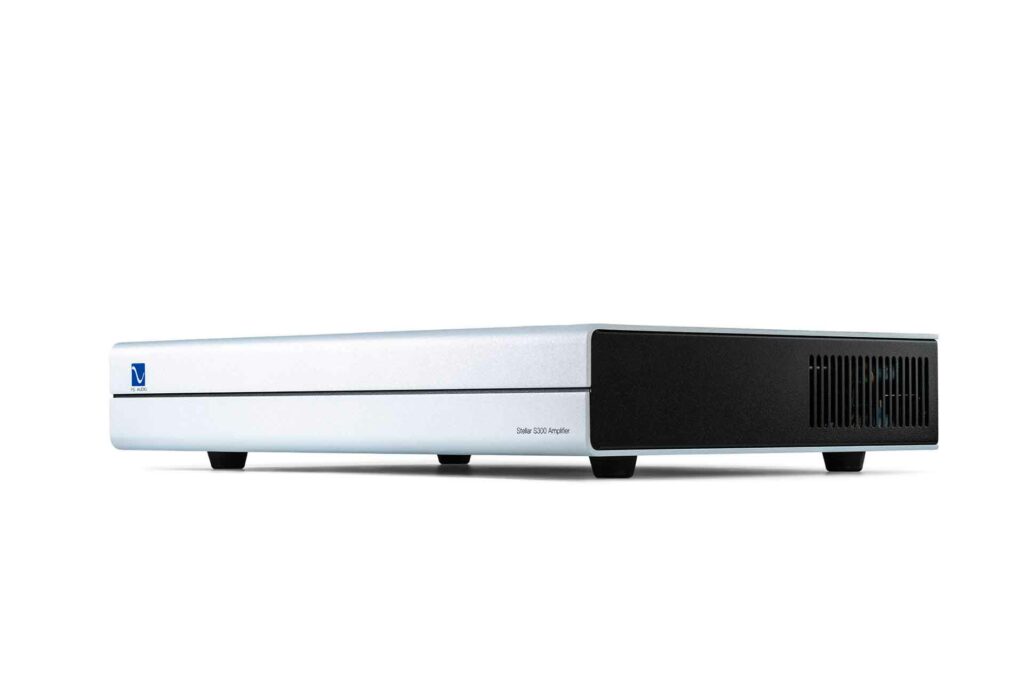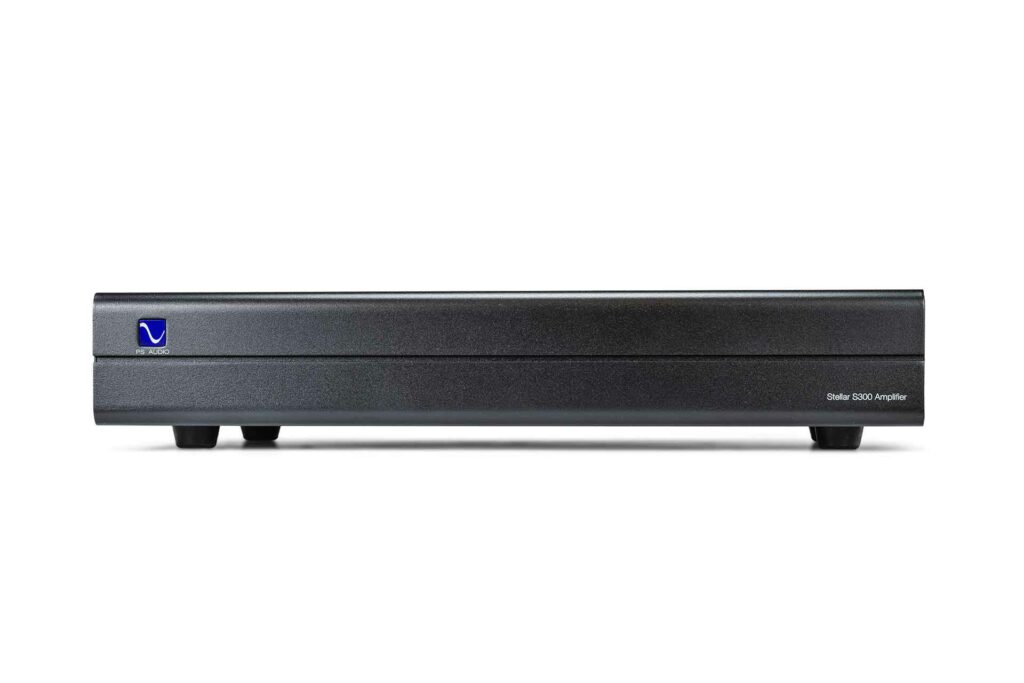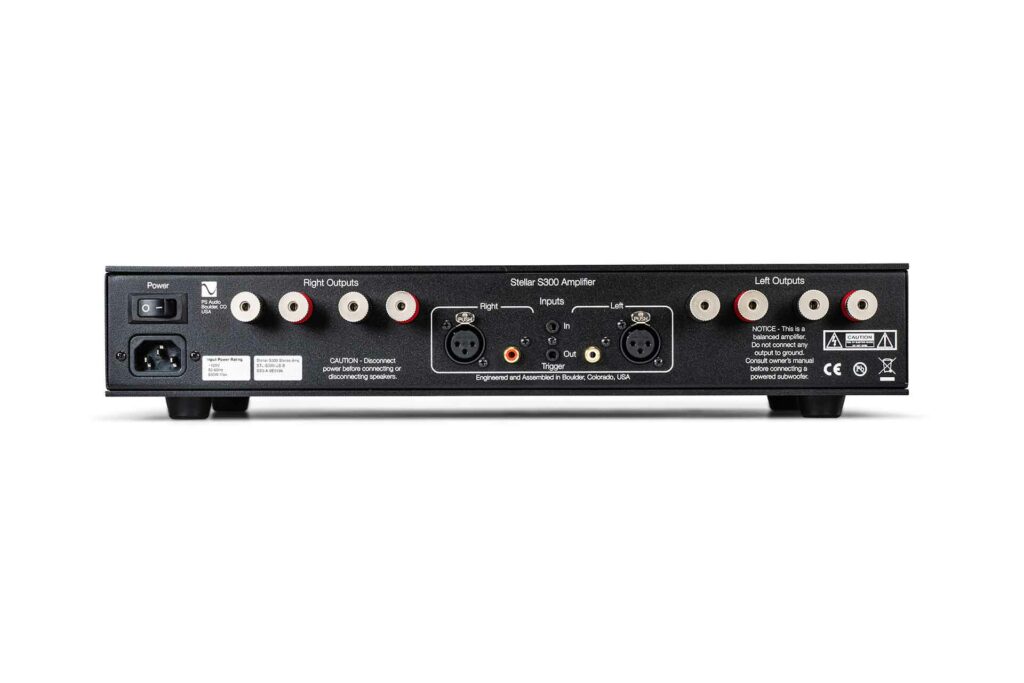The PS Audio Stellar S300 stereo amplifier is PS Audio’s entry-level two-channel amplifier (buy at Amazon) targeted at those thinking of upgrading from a receiver or integrated to quality separates. Make no mistake, though: entry-level or not, this is a serious amplifier.
The Stellar S300 stereo amplifier is a hybrid design, with a proprietary, fully differential, zero feedback, discrete Class A MOSFET circuit (Metal-Oxide-Semiconductor Field-Effect Transistor, common in switching power supplies) based input stage, which PS Audio calls the “Analog Cell.” PS Audio claims its unique Analog Cell is the key to the amplifier’s musicality. The S300 also employs an ultra-linear, high-current Class D ICE module made in Denmark for the output stage. It has a high damping factor for better control of bass. It’s also a dual mono design, with separate power supplies and amplifier stages for each channel.

Manufactured at PS Audio’s factory in Boulder, Colorado, the amp sports a 17-inch-wide chassis of thick, rolled aluminum with a sleek, smooth design. Despite its full-sized width, the S300 features a slim design at just three inches tall and twelve inches deep, with a weight of just 13 pounds. This is possible due to the highly efficient nature of the Class D technology as compared to the much more inefficient Class A or Class AB designs found in big, heavy amplifiers that dominated this domain for decades. Available in either a matte silver or black finish, the Stellar S300 is rated at 140 watts minimum into 8-ohm loads or 300 watts into 4-ohm loads, and is stable down to 2 ohms.
The chassis’ minimalist design sports only a PS Audio logo on the front panel, which also serves to switch the amplifier between ‘standby’ and ‘on’ when pressed. Around back, there are both single-ended RCA and balanced XLR inputs. According to PS Audio, “Regardless of the cable chosen, the Stellar will treat the incoming signal in such a way that it becomes balanced throughout the amplifier’s circuitry.” There are also two sets of high-quality, custom-machined speaker binding posts that accommodate your choice of standard banana plugs, quarter-inch spade terminals, or up to 12AWG (American Wire Gauge) bare wire connections. The second set of speaker binding posts is intended for those wishing to bi-wire their speakers. Whether bi-wiring is beneficial or not has been an ongoing debate since the practice began and is not the intention of this review. In addition, there’s also a 5 Volt – 12 Volt trigger input and output for external control, a power on/off switch, and an IEC 120-volt AC power inlet for connecting the included power cord (or a third party, compatible power cord).

What Makes the PS Audio Stellar S300 Stereo Amplifier Special?
- The unique hybrid design of the PS Audio Stellar stereo amplifier’s Class A Analog Cell input stage and Class D amplifier stage combine to produce a very fast, very musical amplifier. I never felt like the amplifier was struggling to keep up – ever. On the contrary, it was always ready to respond instantly to the next big change dynamics of the music. Vocals were lifelike and the unique character of individual instrument timbres was accurately reproduced.
- The Stellar S300 is characterized as an amplifier with accuracy, poise, and power. It’s equally capable at reproducing the delicacies of low-level background information and the dynamics of sudden, deep bass. Vocal textures and timbre always sounded lifelike and the amp always had a firm grip on the bass, no doubt a result of its high damping factor.
- The PS Audio Stellar S300 stereo amplifier made itself invisible in my system in terms of its tonal balance. The amp doesn’t color or embellish the music in any way, but rather just gets out of the way, disappearing into the background in a very good way. I can’t pay a higher compliment to an amplifier than to acknowledge its neutrality, resulting in more lifelike, accurate sound reproduction. Or, in other words, this amp doesn’t impart its own sound on your overall system, which is the right answer for an audiophile amplifier.
- The fit and finish of the amplifier definitely exudes high-end. The thick, rolled aluminum chassis creates a smooth, streamlined design instead of the more typical sharp edges of most other brands. Even though it’s only thirteen pounds, it feels solidly built. The custom-milled speaker terminals also have a luxury feel about them.

Why Should You Care About the PS Audio Stellar S300 Stereo Amplifier?
It’s rare to come across an amplifier with the unicorn combination of accurate musical performance and affordability that the Stellar S300 stereo amplifier brings to the table. The performance of the amp is proof that Class D amplifier topology, when done right like it is here, should no longer be considered the inferior stepchild of the amplifier world. Rather, Class D design is a very worthy high-end alternative to the more traditional Class A and Class AB designs, without the massive form factor, weight, and heat output of those less efficient designs. Combined with any number of suitable front-end components, including the PS Audio Stellar GainCell DAC/preamplifier ($1,899), the affordable Stellar S300 stereo amplifier is a very worthy point of entry into the world of high-end separates.
Some Things You Might Not Like About the PS Audio Stellar S300 Stereo Amplifier
- There is very little I could find fault with about the Stellar S300. If I’m being picky, there is no Line Out feature to pass the source signal to a second amplifier or receiver located, say, in another room to drive a second set of loudspeakers. While this use case isn’t a common scenario, it is done by some audio enthusiasts.
- A few may wish the rated power output was a bit higher to enable them to drive the very largest, most inefficient loudspeakers in very large rooms. However, I never found myself wishing that the amp had more power when driving my Aerial Acoustics 7T loudspeakers in my medium-sized room. The 7Ts have 4 ohms nominal impedance nominal (3 ohms minimum) and a sensitivity rating of 89 dB for reference. From my listening position of 2.5 meters from the loudspeakers, there was still plenty of power to spare even when pushing the sound output level to extremes of more than 100 dB for brief periods.
- I could additionally nitpick that there is no ability to bridge the two channels to increase power output and add a second amplifier to operate in monoblock fashion, but PS Audio has a more cost-effective answer for that use case. The PS Audio M700 mono amplifier pair ($3,498 buy at Amazon) is rated at 350 watts into 8 ohms or 700 watts into 4 ohms and costs less than a pair of Stellar S300 amps.
Listening to the PS Audio Stellar S300 Stereo Amplifier…
In my evaluation of the S300, I listened to quite a bit of orchestral music. The complex nature and dynamic range of orchestral music can call out deficiencies in current or headroom of amplifiers rather quickly if they’re not up to the task, especially when played at volumes approaching that of a live orchestra. Dynamic orchestral music is useful in evaluating an amplifier’s accuracy at reproducing individual instrumental timbres and resonances. Listening to Gustavo Dudamel conducting the Los Angeles Philharmonic performing the iconic finale of Stravinsky’s Firebird Suite on the album Debussy: La mer – Stravinsky: The Firebird (Live) (Live at Walt Disney Concert Hall, Los Angeles / 2013) (Qobuz, 24-bit/96 kHz), the Stellar S300 exhibited several positive attributes. The tranquil opening solo French horn notes were hauntingly realistic. These quiet notes demonstrated just how important the dead quiet of the S300 is when dictated by the music. The lifelike nuances of the resonance and extended decay of the harpist’s strings, as well as the speed and power of the Stellar S300 when reproducing the explosive tympany later in the finale, showed off the multiple talents of the amp. The words “lifelike” and “accurate” were repeated throughout my listening notes with regard to a wide variety of music. The amp just effortlessly reproduced the unique sound of each instrument without any noticeable coloration. It seemed to always be at the ready for any occasion, no matter what was called for by the music at any moment, without getting in the way by coloring the music in one direction or the other.
I didn’t just focus all of my attention on classical music, though. I also listened to rock, jazz, and quite a bit of pop music. Listening to Charlie Puth’s single “I Warned Myself” (Tidal, 24-bit/44.1 kHz), I was in awe of the speed, power, and complete control that the Stellar S300 exhibited when reproducing the synthesized bass beat in this track. The Aerial Acoustics 7T loudspeakers have a rated frequency response down to 28 Hz, and the PS Audio amp enabled the speakers to deliver on that promise, mining all of the low bass the recording has to offer, which is plenty. And not just bass, but chest thumping, punchy bass that was tight and impactful. And even with the volume well above normal listening levels, the amplifier still had headroom to spare, never seeming to be approaching the limits of its capabilities.
The Stellar S300 enabled the recording to come alive in my listening room, putting a smile on my face and giving me a new appreciation for all of the details in this track. At the same time, the amp displayed finesse while teasing out all of the details in Puth’s breathy solo vocal. It also deftly revealed the nuances of the multi-layered vocal sections where Puth’s voice is overlayed on itself multiple times and also joined by the chorus. For those interested in music production and a peek at the innovative way the specific track was put together, here is a short video.
Does the PS Audio Stellar S300 Stereo Amplifier Have Any Resale Value?
The answer to the resale question is a resounding yes! A value priced amplifier of this quality would be an attractive option for many newer audiophiles wishing to make the leap from a receiver or integrated amplifier to separates without having to sell a kidney to pay for it. And, PS Audio offers a trade-in program on several of their products for those looking to upgrade to a higher priced PS Audio component. And with the build quality and transferrable three-year warranty, the PS Audio Stellar S300 stereo amplifier should hold decent value on the resale market after a few years of use.
Who Is the Competition for the PS Audio Stellar S300 Stereo Amplifier?
Class D amplifiers are continuing to evolve as more and more manufacturers embrace the technology. One PS Audio competitor doing so is Minneapolis manufacturer Bel Canto and its e.One REF501S Class D balanced stereo amplifier ($2,195). Bel Canto has been producing Class D amps for more years than I can remember, steadily improving the design and performance of the architecture. The e.One REF501S has a half-sized chassis (8.5 inches wide), with a maximum power output of 250 watts into 8 ohms, has both RCA single-ended and XLR balanced inputs, and one set of speaker binding posts instead of the two sets found on the Stellar S300.
Another Class D stereo amplifier to consider would be the NAD C 298 stereo amplifier ($2,399 – buy at Crutchfield), with a full-size chassis like the PS Audio, and a rated power output of 185 watts into 8 ohms or 340 watts into 4 ohms. The C 298 has similar inputs to the PS Audio Stellar S300 and Bel Canto REF501S, but like the REF501S, only one set of speaker terminals compared to the two sets of speaker terminals found on the S300. The NAD can be put into bridged mode for monoblock use when paired with a second C 298. It can also be operated at either a fixed gain or a variable gain by selecting the desired option with the fixed/variable input selector on the back. Variable gain may provide better component matching in certain cases. One other additional feature found on the C 298 is a line out connection for daisy-chaining amplifiers for outputting the same source signal to additional speakers, or to the corresponding analog audio input of compatible devices such as amplifiers, receivers, or other applicable devices.
While these additional features potentially expand the use case of the C 298, they do come at a higher cost. A lower cost option would be the NuPrime AMG STA stereo amplifier ($1,750), another half-size chassis Class D amplifier with similar analog inputs and speaker terminals to the Bel Canto and NAD offerings. The NuPrime outputs less power than the PS Audio, with a maximum power output of 130 watts into 8 ohms or 200 watts into 4 ohms.
As I said earlier, there are numerous companies manufacturing Class D amplifiers these days, but the three competitors mentioned here have all been in the Class D game for quite some time and are regularly recognized for creating high quality components.
Final Thoughts on the PS Audio Stellar S300 Stereo Amplifier
The PS Audio Stellar S300 stereo amplifier is a terrific performer and an affordable option for those wishing to upgrade from a receiver or integrated amplifier to separates. It’s not often that an audio product exhibits such high-end performance at such an affordable price, but the S300 hits it out of the park on both counts, and has high-end build quality to boot. It’s the perfect amp for someone looking to enter the world of separates for two-channel playback in a small to medium sized room while avoiding the typical high-end separates price tag.




Hi,
the test bench is good, thank you. But I think it is essential to compare the sound signature of the device with those you quote. Simply in one or two sentences. This allows the reader to situate himself. Regard
This preamp is not Class D. It is pure Class A. Solid state analog vs. Digital